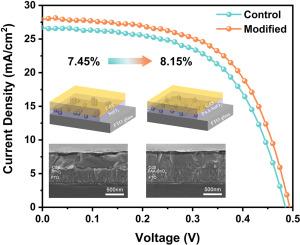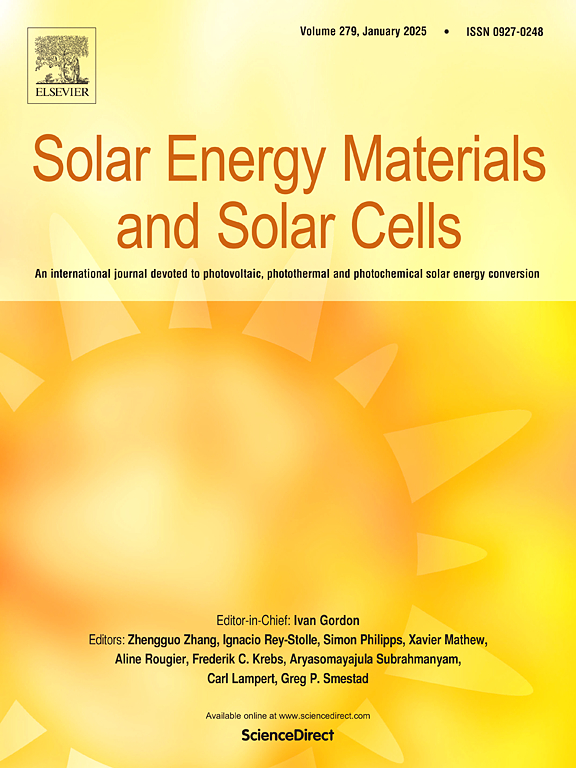Poly(acrylic acid)-modified SnO2/CdS double electron transport layers for efficient and stable Sb2(S,Se)3 solar cells
IF 6.3
2区 材料科学
Q2 ENERGY & FUELS
引用次数: 0
Abstract
Antimony selenosulfide (Sb2(S,Se)3) solar cells hold significant promise for sustainable photovoltaic technology due to their adjustable band gap, high absorption coefficient and good stability. In terms of device operation, the transfer of electrons from the Sb2(S,Se)3 layer to the electron transport layer (ETL) plays a crucial role in improving the photovoltaic performance of solar cells. Until now, high-efficiency Sb2(S,Se)3 solar cells have typically employed cadmium sulfide (CdS) as the ETL. However, inadequate interface contact between the CdS and the Sb2(S,Se)3 layer often results in severe interface recombination, and the parasitic light absorption of CdS restricts the short-circuit current density (Jsc). Therefore, the development of high-quality CdS film along with reduction of cadmium element usage remains an import issue for the Sb2(S,Se)3 solar cells. Herein, the poly(acrylic acid)-modified tin oxide (PAA-SnO2)/CdS double ETLs are introduced to improve the quality of both the CdS film and Sb2(S,Se)3 film, while also strengthening the interface contact between CdS and Sb2(S,Se)3. The power conversion efficiency of the corresponding solar cells increases from 7.45% in the control device to 8.15% in the modified device. This work provides a simple PAA-modified SnO2-assisted CdS ETL strategy to improve the interface of CdS/Sb2(S,Se)3, thereby achieving efficient and stable Sb2(S,Se)3 solar cells.

聚丙烯酸修饰SnO2/CdS双电子传输层制备高效稳定的Sb2(S,Se)3太阳能电池
硒化硫化锑(Sb2(S,Se)3)太阳能电池具有可调带隙、高吸收系数和良好的稳定性,在可持续光伏技术中具有重要的应用前景。在器件操作方面,电子从Sb2(S,Se)3层向电子传输层(ETL)的转移对提高太阳能电池的光伏性能起着至关重要的作用。到目前为止,高效的Sb2(S,Se)3太阳能电池通常使用硫化镉(cd)作为ETL。然而,CdS与Sb2(S,Se)3层之间的界面接触不足往往导致严重的界面复合,并且CdS的寄生光吸收限制了短路电流密度(Jsc)。因此,开发高质量的cd薄膜并减少镉元素的使用仍然是Sb2(S,Se)3太阳能电池的重要问题。本文介绍了聚丙烯酸修饰的氧化锡(PAA-SnO2)/CdS双ETLs,提高了CdS薄膜和Sb2(S,Se)3薄膜的质量,同时加强了CdS与Sb2(S,Se)3之间的界面接触。相应的太阳能电池的功率转换效率从控制装置中的7.45%提高到改进装置中的8.15%。本工作提供了一种简单的paa修饰sno2辅助CdS ETL策略,以改善CdS/Sb2(S,Se)3的界面,从而实现高效稳定的Sb2(S,Se)3太阳能电池。
本文章由计算机程序翻译,如有差异,请以英文原文为准。
求助全文
约1分钟内获得全文
求助全文
来源期刊

Solar Energy Materials and Solar Cells
工程技术-材料科学:综合
CiteScore
12.60
自引率
11.60%
发文量
513
审稿时长
47 days
期刊介绍:
Solar Energy Materials & Solar Cells is intended as a vehicle for the dissemination of research results on materials science and technology related to photovoltaic, photothermal and photoelectrochemical solar energy conversion. Materials science is taken in the broadest possible sense and encompasses physics, chemistry, optics, materials fabrication and analysis for all types of materials.
 求助内容:
求助内容: 应助结果提醒方式:
应助结果提醒方式:


